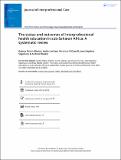Files in this item
The status and outcomes of interprofessional health education in sub-Saharan Africa : a systematic review
Item metadata
| dc.contributor.author | Kitema, Gatera Fiston | |
| dc.contributor.author | Laidlaw, Anita Helen | |
| dc.contributor.author | O'Carroll, Veronica | |
| dc.contributor.author | Sagahutu, Jean Baptiste | |
| dc.contributor.author | Blaikie, Andrew | |
| dc.date.accessioned | 2023-02-13T17:30:02Z | |
| dc.date.available | 2023-02-13T17:30:02Z | |
| dc.date.issued | 2024-01-01 | |
| dc.identifier | 282960220 | |
| dc.identifier | 16c8dd81-da41-42cb-942a-4fa76f64508b | |
| dc.identifier | 85147713028 | |
| dc.identifier | 85147713028 | |
| dc.identifier | 36739570 | |
| dc.identifier.citation | Kitema , G F , Laidlaw , A H , O'Carroll , V , Sagahutu , J B & Blaikie , A 2024 , ' The status and outcomes of interprofessional health education in sub-Saharan Africa : a systematic review ' , Journal of Interprofessional Care , vol. 38 , no. 1 , pp. 133-155 . https://doi.org/10.1080/13561820.2023.2168631 | en |
| dc.identifier.issn | 1356-1820 | |
| dc.identifier.other | ORCID: /0000-0001-7913-6872/work/129146144 | |
| dc.identifier.other | ORCID: /0000-0003-1214-4100/work/129146277 | |
| dc.identifier.other | ORCID: /0000-0001-5777-104X/work/129147952 | |
| dc.identifier.other | ORCID: /0000-0002-1623-9302/work/129148053 | |
| dc.identifier.uri | https://hdl.handle.net/10023/26968 | |
| dc.description | Funding: Review conducted under the Global Challenges Research Fund (GCRF) PhD scholarship at the University of St Andrews. | en |
| dc.description.abstract | The increasing burden of chronic diseases, and shortage of health care workers especially in Low and Middle Income countries (LMICs) requires greater collaborative working between health professions. There is a growing body of evidence that interprofessional education (IPE) and interprofessional continuous education (IPCE) can improve collaborative practice thus strengthening health care delivery in low resource settings. The World Health Organization (WHO) promotes this educational strategy in these regions as part of wider programs to improve health care. The purpose of this systematic review was to summarize IPE and IPCE activities in sub-Saharan Africa (SSA) and its outcomes; including practice, service and patient outcomes. Standard guidelines for conducting and reporting systematic reviews were followed. The online databases searched included MEDLINE, Embase, Education Resources Information Centre (ERIC), the Cumulative Index of Nursing and Allied Health Literature (CINAHL) and Science Direct. The Kirkpatrick model was used to classify IPE outcomes reported from literature. Following full text screening, 41 articles were selected for data extraction. It was found that IPE/IPCE is still a relatively new concept in SSA with 93% of studies published after 2012. Furthermore, IPE is concentrated predominantly in undergraduate institutions and mainly implemented to improve collaborative practice and address important public health concerns. Positive reaction and outcomes of IPE/IPCE were reported in terms of change of attitude and perception toward collaborative practice as well as knowledge and skills acquisition. Few studies in SSA sought to understand and measure the outcomes of IPE/IPCE relating to health care practice. More work in this important potential outcome of IPE/IPCE is recommended. | |
| dc.format.extent | 23 | |
| dc.format.extent | 1814421 | |
| dc.language.iso | eng | |
| dc.relation.ispartof | Journal of Interprofessional Care | en |
| dc.subject | Collaborative practice | en |
| dc.subject | Health education | en |
| dc.subject | Interdisciplinary practice | en |
| dc.subject | Interprofessional education | en |
| dc.subject | Sub-Saharan Africa | en |
| dc.subject | RA Public aspects of medicine | en |
| dc.subject | Medicine(all) | en |
| dc.subject | 3rd-DAS | en |
| dc.subject | SDG 3 - Good Health and Well-being | en |
| dc.subject | SDG 4 - Quality Education | en |
| dc.subject | MCC | en |
| dc.subject.lcc | RA | en |
| dc.title | The status and outcomes of interprofessional health education in sub-Saharan Africa : a systematic review | en |
| dc.type | Journal article | en |
| dc.contributor.sponsor | Scottish Funding Council | en |
| dc.contributor.institution | University of St Andrews. Infection and Global Health Division | en |
| dc.contributor.institution | University of St Andrews. School of Medicine | en |
| dc.contributor.institution | University of St Andrews. Population and Behavioural Science Division | en |
| dc.contributor.institution | University of St Andrews. Education Division | en |
| dc.contributor.institution | University of St Andrews. Centre for Higher Education Research | en |
| dc.contributor.institution | University of St Andrews. Sir James Mackenzie Institute for Early Diagnosis | en |
| dc.identifier.doi | https://doi.org/10.1080/13561820.2023.2168631 | |
| dc.description.status | Peer reviewed | en |
| dc.identifier.grantnumber | N/A | en |
This item appears in the following Collection(s)
Items in the St Andrews Research Repository are protected by copyright, with all rights reserved, unless otherwise indicated.

